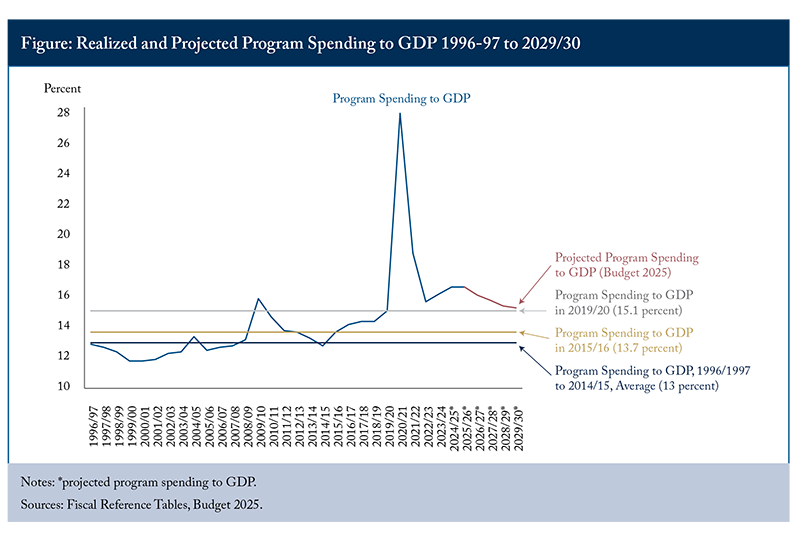Home / Publications / Intelligence Memos / Is Spending Restrained or Bloated in the 2025 Federal Budget?
- Intelligence Memos
- |
Is Spending Restrained or Bloated in the 2025 Federal Budget?
Summary:
| Citation | Nicholas Dahir and Drummond, Don. 2025. "Is Spending Restrained or Bloated in the 2025 Federal Budget?." Intelligence Memos. Toronto: C.D. Howe Institute. |
| Page Title: | Is Spending Restrained or Bloated in the 2025 Federal Budget? – C.D. Howe Institute |
| Article Title: | Is Spending Restrained or Bloated in the 2025 Federal Budget? |
| URL: | https://cdhowe.org/publication/is-spending-restrained-or-bloated-in-the-2025-federal-budget/ |
| Published Date: | November 11, 2025 |
| Accessed Date: | November 12, 2025 |
Outline
Outline
Related Topics
Files
From: Don Drummond and Nick Dahir
To: : Federal spending observers
Date: November 11, 2025
Re: Is Spending Restrained or Bloated in the 2025 Federal Budget?
In its new budget plan the federal government makes the case spending is restrained by emphasizing how much is being saved.
“The Comprehensive Expenditure Review will rein in government spending – saving Canada $13 billion annually by 2028-29, for a total with other savings and revenues of $60 billion over five years,” it proclaimed. Such claims of savings do not necessarily mean spending is restrained. They just mean the government intends to spend less than in previous plans.
To answer the question whether spending is restrained or bloated in the budget we must first introduce a benchmark. The benchmark we used is the ratio of program spending (total spending less public debt charges) to total economic activity, gross domestic product (GDP). While this ratio can cycle, it is one of the better indicators of the size of government over time.
Over the 19 years 1996/97 to 2014/15, program spending averaged 13 percent of GDP. That average includes a few years of elevated spending following the financial crisis and ensuing recession. By 2015/16, the first year of the Trudeau Liberal government, the ratio had risen to 13.7 percent. It went up to 15.1 percent by 2019/20, the year before the pandemic. At that time, the Trudeau government had planned to bring the ratio down to 14.2 percent by 2023/24.
Instead, program spending as a ratio of GDP soared to 28.1 percent in the pandemic of 2020/21. It has been coming down since. By 2029/30, the last year in the 2025 Budget’s projection, there will have been nine years to bring spending as a portion of the economy back to a reasonable benchmark. But, at 15.3 percent, the 2025 Budget is planning a 2029/30 ratio that is still higher than it was in 2019/20, 2015/16 and the average of 1996/97 to 2014/15.

Returning to the ratio of program spending to GDP in these three benchmarks would require the following additional cuts from the 2029/30 projection:
2019/20 $7.2 billion
2015/16 58.8
1996/97 to 2014/15 average 84.6
Instead of annual savings in 2029/30 of $13 billion announced in the 2025 Budget, these benchmarks would require total cuts of $20.2 billion, 71.8 billion and 97.6 billion.
Delivering cuts of these magnitudes would require a much more thorough and deeper expenditure review likely affecting transfers to persons and provinces as well as direct federal spending.
From the perspective of the historical benchmarks of program spending relative to GDP, spending is bloated in the 2025 Budget, despite the rhetoric of cuts.
Don Drummond is the Stauffer-Dunning Fellow in Global Public Policy and Adjunct Professor at the School of Policy Studies at Queen’s University and a Fellow-In-Residence at the C.D. Howe Institute, where Nick Dahir is a Research Officer.
To send a comment or leave feedback, email us at blog@cdhowe.org.
The views expressed here are those of the authors. The C.D. Howe Institute does not take corporate positions on policy matters.
Want more insights like this? Subscribe to our newsletter for the latest research and expert commentary.
Related Publications
- Intelligence Memos
- Intelligence Memos
- Research


